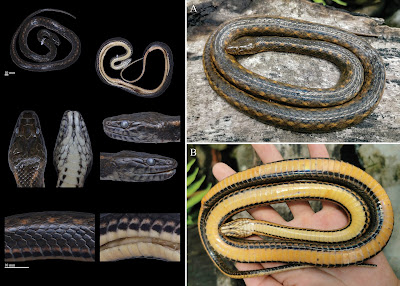 |
| Hebius citrinoventer Xu, Yang, Ouyang, Huang & Peng, in Xu, Yang, Gong, Ouyang, Weng, Deng, Huang et Peng, 2024. |
Abstract
A new species of the genus Hebius Thompson, 1913 is described from Yingjiang County, Dehong Dai and Jingpo Autonomous Prefecture, Yunnan Province, China, based on molecular and morphological evidence. It can be distinguished from its congeners by the following set of characters: (1) dorsal scale rows 19–17–17, feebly keeled; (2) ventrals 146–151; (3) nasal complete, nostril in the middle of the nasal; (4) supralabials 9, the fourth to sixth in contact with the eye; (5) infralabials 10–11, the first 5 touching the first pair of chin shields; (6) preoculars 2; (7) postoculars 3; (8) temporals 3, arranged in two rows (1+2); (9) maxillary teeth 31, the last 4 slightly enlarged, without diastema; (10) tail comparatively long, TAL/TL ratio 0.334 in the male; (11) dorsolateral series of irregular orange or ochre yellow blotches, extending from the neck to the posterior part of the tail; and (12) venter pale orange, tips of ventrals with subrectangular black blotches. All Hebius specimens were strongly recovered as monophyletic, in which Hebius taronensis (Smith, 1940) and Hebius venningi (Wall, 1910) were monophyletic as sister to the Yingjiang County specimens. According to the p‐distance of cytochrome b, the new species differs from its congeners by 9.7–15.4%.
Key words: Cyt b, Hebius citrinoventer sp. nov., keelback snake, molecular systematics, Natricinae, taxonomy, Yingjiang County
 |
| Preserved specimen of the holotype (ANU20230016) of Hebius citrinoventer sp. nov. Photos by Yu-Hao Xu. Scale bars: 10 mm. |
 |
| Fresh specimen of the holotype (ANU20230016) of Hebius citrinoventer sp. nov.: dorsal (A), and ventral views (B). Photos by Kai-Chen Ouyang. Scale bars are not shown. |
Hebius citrinoventer Xu, Yang, Ouyang, Huang & Peng, sp. nov.
Diagnosis: Hebius citrinoventer sp. nov. can be distinguished from its congeners by the following set of characters: (1) DSR 19–17–17, feebly keeled; (2) ventrals 146–151; (3) nasal complete, nostril in the middle of the nasal; (4) supralabials 9, the fourth to sixth in contact with the eye; (5) infralabials 10–11, the first 5 touching the first pair of chin shields; (6) preoculars 2; (7) postoculars 3; (8) temporals 3, arranged in two rows (1+2); (9) maxillary teeth 31, the last 4 slightly enlarged, without diastema; (10) tail comparatively long, TAL/TL ratio 0.334 in male; (11) dorsolateral series of irregular orange or ochre yellow blotches, extending from the neck to the posterior part of the tail; and (12) venter pale orange, tips of ventrals with subrectangular black blotches.
Etymology: The specific name citrinoventer comprises the Latin words “citrinus” (yellowish-orange or orange) and “venter” (the belly or underside), based on the pale orange venter of the new species. According to its type locality Yingjiang County, Yunnan Province, China, the name we suggest is Yíng Jiāng Fù Liàn Shé (盈江腹链蛇) in Chinese and Yingjiang Keelback Snake in English.
Yu-Hao Xu, Dian-Cheng Yang, Yan-An Gong, Kai-Chen Ouyang, Shi-Yang Weng, Jun-Dong Deng, Song Huang and Li-Fang Peng. 2024. A New Species of the Genus Hebius (Squamata, Natricidae) from Yunnan, China. ZooKeys. 1206: 255-274. DOI: 10.3897/zookeys.1206.123841